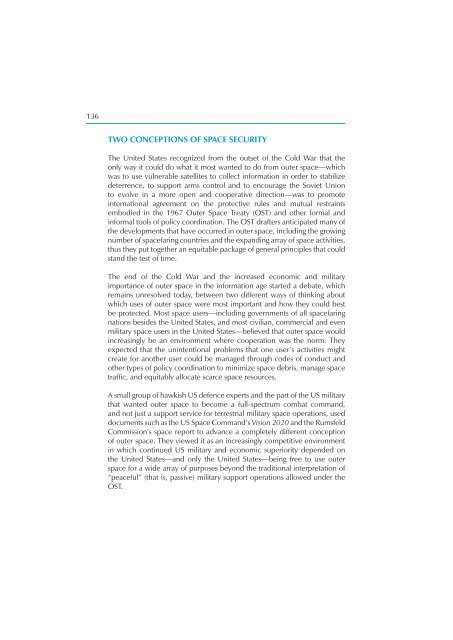Security in Space The Next Generation - UNIDIR
Security in Space The Next Generation - UNIDIR
Security in Space The Next Generation - UNIDIR
Create successful ePaper yourself
Turn your PDF publications into a flip-book with our unique Google optimized e-Paper software.
136<br />
TWO CONCEPTIONS OF SPACE SECURITY<br />
<strong>The</strong> United States recognized from the outset of the Cold War that the<br />
only way it could do what it most wanted to do from outer space—which<br />
was to use vulnerable satellites to collect <strong>in</strong>formation <strong>in</strong> order to stabilize<br />
deterrence, to support arms control and to encourage the Soviet Union<br />
to evolve <strong>in</strong> a more open and cooperative direction—was to promote<br />
<strong>in</strong>ternational agreement on the protective rules and mutual restra<strong>in</strong>ts<br />
embodied <strong>in</strong> the 1967 Outer <strong>Space</strong> Treaty (OST) and other formal and<br />
<strong>in</strong>formal tools of policy coord<strong>in</strong>ation. <strong>The</strong> OST drafters anticipated many of<br />
the developments that have occurred <strong>in</strong> outer space, <strong>in</strong>clud<strong>in</strong>g the grow<strong>in</strong>g<br />
number of spacefar<strong>in</strong>g countries and the expand<strong>in</strong>g array of space activities,<br />
thus they put together an equitable package of general pr<strong>in</strong>ciples that could<br />
stand the test of time.<br />
<strong>The</strong> end of the Cold War and the <strong>in</strong>creased economic and military<br />
importance of outer space <strong>in</strong> the <strong>in</strong>formation age started a debate, which<br />
rema<strong>in</strong>s unresolved today, between two different ways of th<strong>in</strong>k<strong>in</strong>g about<br />
which uses of outer space were most important and how they could best<br />
be protected. Most space users—<strong>in</strong>clud<strong>in</strong>g governments of all spacefar<strong>in</strong>g<br />
nations besides the United States, and most civilian, commercial and even<br />
military space users <strong>in</strong> the United States—believed that outer space would<br />
<strong>in</strong>creas<strong>in</strong>gly be an environment where cooperation was the norm. <strong>The</strong>y<br />
expected that the un<strong>in</strong>tentional problems that one user’s activities might<br />
create for another user could be managed through codes of conduct and<br />
other types of policy coord<strong>in</strong>ation to m<strong>in</strong>imize space debris, manage space<br />
traffi c, and equitably allocate scarce space resources.<br />
A small group of hawkish US defence experts and the part of the US military<br />
that wanted outer space to become a full-spectrum combat command,<br />
and not just a support service for terrestrial military space operations, used<br />
documents such as the US <strong>Space</strong> Command’s Vision 2020 and the Rumsfeld<br />
Commission’s space report to advance a completely different conception<br />
of outer space. <strong>The</strong>y viewed it as an <strong>in</strong>creas<strong>in</strong>gly competitive environment<br />
<strong>in</strong> which cont<strong>in</strong>ued US military and economic superiority depended on<br />
the United States—and only the United States—be<strong>in</strong>g free to use outer<br />
space for a wide array of purposes beyond the traditional <strong>in</strong>terpretation of<br />
“peaceful” (that is, passive) military support operations allowed under the<br />
OST.








